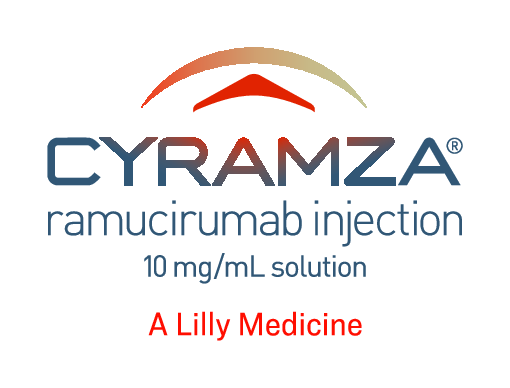What is the Starter Kit?
You and your doctor made the choice that CYRAMZA® (sigh-RAM-zuh) is right for you. This Starter Kit gives you details about CYRAMZA, explains what to expect, and provides financial information. All of this will help you to start in the right direction during your first weeks of using CYRAMZA.
Meet CYRAMZA
How does CYRAMZA work? CYRAMZA is not a traditional chemotherapy. It is a type of treatment called an anti-angiogenic. This means CYRAMZA is thought to block the development of new blood vessels. (Tubular structures, such as veins, arteries, or capillaries, that carry blood through tissues and organs.) The development of new blood vessels is called angiogenesis.
Metastatic Non-Small Cell Lung Cancer (NSCLC)
CYRAMZA is used with a chemotherapy called docetaxel to treat metastatic non-small cell lung cancer (NSCLC) in adults whose cancer has progressed on or after being treated with other initial types of chemotherapy. Adults who have tumors with epidermal growth factor receptor (EGFR) or anaplastic lymphoma kinase (ALK) gene changes should have disease progression on or after a therapy that targets these gene changes prior to receiving CYRAMZA.
SELECT SAFETY INFORMATION
CYRAMZA may cause serious side effects, including:
Severe bleeding, including bleeding in the stomach or bowel, has happened with CYRAMZA. This can be life threatening. Tell your doctor right away if you have bleeding or symptoms of bleeding, including lightheadedness. If severe bleeding happens, you will have to stop receiving CYRAMZA.
You've decided to move forward and are ready to start treatment.
CYRAMZA is given in combination with docetaxel. Both CYRAMZA and docetaxel are given by intravenous infusion, commonly referred to as an IV. The medicines will be delivered into your vein. A doctor or nurse will administer treatment at the doctor’s office, a hospital, or an infusion center.
Before you receive treatment with CYRAMZA, your doctor will administer different medicines to help prevent an allergic reaction that may occur during infusion.
When you receive CYRAMZA with docetaxel, treatment will be given on the first day of a 21-day cycle. CYRAMZA will be given first, followed by docetaxel. The first infusions will take about 60 minutes each. Your doctor will determine the number of treatments you receive. If you handle the first infusion of CYRAMZA well, then your next CYRAMZA infusions may only take 30 minutes. CYRAMZA and docetaxel will be given once
every 3 weeks.
SELECT SAFETY INFORMATION
CYRAMZA may cause serious side effects, including:
Reactions related to infusing CYRAMZA have happened. These can be severe and life threatening. Most of these reactions happened during or after the first or second CYRAMZA infusion. Symptoms of infusion reactions include shaking or stiffness of the body, back pain or spasms, chest pain or tightness, chills, flushing (sudden warmth and/or reddened skin on the face, neck, or upper chest), difficulty breathing, wheezing (a whistling sound in the breath caused by narrowed breathing tubes), becoming blue due to lack of oxygen, and tingling or numbness of the skin. In severe reactions, rapid heartbeat, low blood pressure, and severe trouble breathing may happen. Your health care team will give you medicine before each CYRAMZA infusion and will watch you for these side effects. If a reaction happens, CYRAMZA treatment may be infused at a slower rate or may be permanently stopped, depending on how severe the reaction is.
